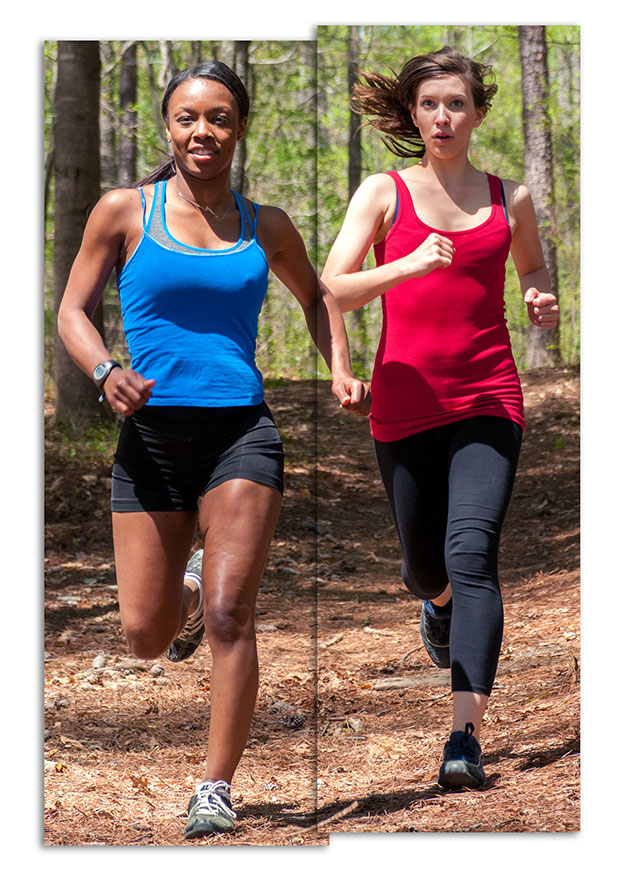 Study findings regarding strengthening interventions in runners with patellofemoral pain syndrome have been inconsistent, perhaps because specific subgroups are more responsive than others. Preliminary research suggests high school runners may make up one such subgroup.
Study findings regarding strengthening interventions in runners with patellofemoral pain syndrome have been inconsistent, perhaps because specific subgroups are more responsive than others. Preliminary research suggests high school runners may make up one such subgroup.
By Lace Luedke, PT, DPT, PhD, OCS, CSCS
Running continues to be a popular recreational activity, with more than 28 million Americans running 50 or more times per year in 2014.1 However, while running confers many health benefits, the injury incidence is high, with reports of 19.4% to 79.3% of runners experiencing injury.2 The knee, lower leg, and foot are the most commonly injured locations in runners,3 and strengthening exercises are frequently used for the treatment of injured runners to address areas of impaired or asymmetrical strength.4-7 Strength training has been associated with improvements in running economy,8 and strengthening exercises are often suggested for prevention of common running injuries.9-13 Although it’s plausible that strengthening interventions may reduce injury risk in runners, the current evidence to support these interventions is lacking.
Strength impairments in injured runners
Most evidence available on the relationship between lower extremity strength and injuries in runners comes from cross-sectional studies on recreational runners. Strength impairments in injured runners are common. In a cross-sectional study of 25 recreational runners, Ferber et al observed that runners with patellofemoral pain syndrome (PFPS) presented with a 30% deficit in hip abductor strength compared with asymptomatic runners.12 In another study, runners with PFPS demonstrated weaker hip abductor muscles than healthy runners, both prior to and after an exhaustive treadmill run.14
 Hip abduction strength deficits have also been reported in the involved limb of female runners with iliotibial band syndrome.15 Similarly, in a cross-sectional study of 60 recreational runners, Niemuth et al found that runners with overuse injuries displayed worse hip abductor strength in their involved limb compared with noninjured runners.16 In athletes with PFPS, less hip abduction and external rotation strength has been reported in the involved limb than the uninvolved limb; the same study reported global hip strength impairments in those with PFPS, compared with age- and sport-matched women without PFPS.17 However, a more recent study on female runners in early stages of PFPS did not find significant hip abduction strength asymmetry, and hip abduction strength in hip extension was not impaired relative to noninjured runners.18
Hip abduction strength deficits have also been reported in the involved limb of female runners with iliotibial band syndrome.15 Similarly, in a cross-sectional study of 60 recreational runners, Niemuth et al found that runners with overuse injuries displayed worse hip abductor strength in their involved limb compared with noninjured runners.16 In athletes with PFPS, less hip abduction and external rotation strength has been reported in the involved limb than the uninvolved limb; the same study reported global hip strength impairments in those with PFPS, compared with age- and sport-matched women without PFPS.17 However, a more recent study on female runners in early stages of PFPS did not find significant hip abduction strength asymmetry, and hip abduction strength in hip extension was not impaired relative to noninjured runners.18
In a cross-sectional study of 169 recreational runners, Duffey et al reported that decreased peak knee extensor torque was a predictor of anterior knee pain (AKP).19 Knee extensor strength was also decreased in recreational runners with chronic low back pain.20 In contrast, Messier et al reported similar knee extensor and flexor strength values among recreational runners aged 16 to 50 years with and without PFPS, but the runners with PFPS tended to have greater knee flexion and less knee extension endurance bilaterally than controls, despite unilateral symptoms.21
Strength impairments have also been reported in runners with calf and foot injuries. In a sample of 12 female marathoners, decreased toe flexor strength was associated with a higher rate of posterior-medial shin pain and a lower arch.22 Lower peak plantar flexion torque than healthy runners was observed at 180°/sec in runners with Achilles tendinitis23 and at 60°/sec and 180°/sec in runners with plantar fasciitis.24
Strength and running injury risk
 While strength impairments are often observed in injured runners, whether these impairments are causative factors or secondary to the injury is not clear.11 Prospective studies assessing strength values prior to injury occurrence may help determine which strength impairments are risk factors.
While strength impairments are often observed in injured runners, whether these impairments are causative factors or secondary to the injury is not clear.11 Prospective studies assessing strength values prior to injury occurrence may help determine which strength impairments are risk factors.
Hip muscle strength and function may be risk factors for knee injuries.25 A lower preinjury hip external-to-internal rotation strength ratio was associated with increased AKP risk in a prospective study of 98 high school distance runners.26 In a study of more than 600 novice adult recreational runners, those with higher eccentric hip abductor strength had a lower risk of developing PFPS.27 In contrast, a study of 77 novice female distance runners reported that hip flexor, extensor, abductor, adductor, external rotation, and internal rotation isometric strength did not predict which runners would experience PFPS during a 10-week running program.28 Knee flexion and extension strength may influence knee injury as decreased isometric hamstrings and quadriceps strength were significant risk factors for AKP in US Naval Academy midshipmen.29
With regard to shin injuries, Verrelst et al found that decreased hip abduction strength predicted the development of exertional medial tibial pain during running in a prospective study of 95 female physical education students.30 In contrast, greater hip abduction strength was not protective against medial tibial stress syndrome or tibial stress fracture in a study of 230 high school runners.31 In a prospective study of 125 collegiate cross country runners, distal strength values didn’t influence shin injury incidence, as reduced isotonic ankle plantar flexor endurance was not significantly associated with incidence of exercise-related lower leg pain.32 Additionally, in a study of 146 collegiate athletes, isometric strength of the ankle plantar flexors, dorsiflexors, invertors, and evertors was not associated with occurrence of medial tibial stress syndrome.33 In a study that assessed isometric trunk, hip, and knee strength in recreational runners, decreased knee flexor strength was associated with the development of Achilles tendon pain in runners.34
Although strength was not assessed in Bennell et al’s prospective investigation of 111 track and field athletes aged 17 to 26 years, female athletes with stress fractures (most frequently to the tibia) had less lean mass in the lower limb and smaller calf girth than female track and field athletes who did not incur a stress fracture.35,36 Track and field athletes with a 1-cm deficit in corrected calf girth were also four times more likely to incur a stress fracture.35 Bennell et al also found that corrected calf girth and lower limb lean mass were positively correlated with tibial and fibular bone density,37 suggesting lean mass may be protective against stress fractures in runners.
Our recent study
Like recreational running, high school cross-country running is also very popular, with participation increasing by more than 30% in the past decade.38,39 However, 59% to 68% of high school distance runners report a history of running injury.40 In high school runners, the shin and knee have been the most frequently reported injured areas, together representing 48% of new injuries and 59% of reinjuries.40,41 We conducted a study to determine if hip and knee strength was associated with the incidence of shin and knee injuries in high school cross-country runners.
At the start of the interscholastic season, 68 high school cross-country runners (47 girls) were tested for peak isometric hip abductor, knee extensor, and knee flexor strength using a handheld dynamometer. Values were normalized to body mass. During the season, runners were tracked for athletic exposures (practice and competition participation) and occurrences of AKP and shin injuries that resulted in time lost from practice or competition. Runners were categorized by their strength values into weakest, middle, and strongest tertiles for each muscle group; the strongest group was used as the reference group.
Runners in the weakest tertiles for hip abductor, knee extensor, and knee flexor strength were more likely to experience AKP than those in the strongest tertile.42 The incidence of shin injury was higher for runners in the weakest tertile for hip abductor strength than the strongest tertile, but the relationship was not statistically significant. Runners in the weakest tertiles for knee extensor strength and knee flexor strength did not have an increased risk of shin injury.42
In our study, high school runners with weaker hip abductor and knee strength values had a higher risk of AKP than their stronger counterparts. However, we concluded further evidence is needed to determine whether screening for strength impairments and interventions targeting strength impairments will reduce risk of running injuries.
Clinical implications
 The inconsistent findings in the literature on associations between lower extremity strength and running injury occurrence are likely because running injuries are multifactorial. Anatomy, biomechanics, and training load may all contribute to injury occurrence.
The inconsistent findings in the literature on associations between lower extremity strength and running injury occurrence are likely because running injuries are multifactorial. Anatomy, biomechanics, and training load may all contribute to injury occurrence.
Strengthening may improve runners’ ability to tolerate loads associated with running. Theoretically, screening for hip muscle weakness and adding strengthening exercises may help prevent AKP in female athletes.17 Additionally, strength training of the hamstrings in runners has been proposed to lower the risk of knee and soft tissue injuries,13 as the hamstrings are thought to be important for maintaining stride mechanics due to their role in controlling braking forces at the knee.43
While muscle strength may improve tolerance of loads during running, another reason for inconsistencies in the reported relationships between strength and injury risk may be that strength is typically assessed isometrically. It’s unclear how much of an influence peak isometric strength has on the dynamic task of running, and specifically on prolonged running in the presence of muscular fatigue.44 Schmitz et al found that, while isometric hip strength values were similar between novice and experienced runners, hip internal rotation motion during running was higher in the novice runners,45 suggesting isometric strength may not correlate strongly with muscular control and kinematics during running.44-46
Strengthening exercises are effective for increasing strength. Runners who, in addition to their running, participated in a six-week strengthening program for hip abductors and external rotators increased their strength and reduced hip internal rotation during running.46 Although this intervention appeared to influence injury risk factors, injury incidence after the intervention was not assessed directly.47
In other studies, hip strengthening exercises in runners with PFPS increased their hip strength values without changing running mechanics,48 while heavy strength training in female runners resulted in improved 1RM (one-repetition maximum) for leg exercises.49 Active individuals with PFPS who participated in six weeks of either hip or knee strengthening had similar success rates for improvements in symptoms and function and increases in strength parameters.50 However, participants in the hip-strengthening group started experiencing significant improvements in self-reported pain at three weeks, while those in the knee-strengthening group started at four weeks.50
With respect to strengthening exercises for running injury prevention, a preconditioning program implemented with the intent of improving strength and load tolerance in 432 novice runners didn’t significantly reduce incidence of running-related injury.51 The experimental preconditioning program included four weeks of progressive walking and hopping before starting a nine-week running program; injury rates during the nine weeks of running were similar for the preconditioning program participants and nonparticipants.51
 In other sports, strengthening programs added to training have reduced injury rates. A structured warm-up program to improve neuromuscular control, balance, and strength in youth handball players reduced the injury rate in the intervention group (.5 injuries per 1000 player hours) compared with a control group (.9 injuries per 1000 player hours).52 In adolescent soccer players, an intervention group added two to three sessions of plyometrics per week and strengthening to their regular training program for 12 weeks. Over the course of the season, those in the experimental group experienced a lower rate of injuries lasting three or more days than the control group (.70 injuries per 1000 hours of sport exposure vs 2.32 injuries per 1000 hours).53
In other sports, strengthening programs added to training have reduced injury rates. A structured warm-up program to improve neuromuscular control, balance, and strength in youth handball players reduced the injury rate in the intervention group (.5 injuries per 1000 player hours) compared with a control group (.9 injuries per 1000 player hours).52 In adolescent soccer players, an intervention group added two to three sessions of plyometrics per week and strengthening to their regular training program for 12 weeks. Over the course of the season, those in the experimental group experienced a lower rate of injuries lasting three or more days than the control group (.70 injuries per 1000 hours of sport exposure vs 2.32 injuries per 1000 hours).53
In elite soccer players, adding eccentric and concentric hamstring strengthening exercises improved hamstring strength and reduced hamstring injury incidence.54 Another study on elite soccer players noted fewer muscular injuries with the addition of functional strength, proprioceptive, core stability, and agility exercises.55 A group of female floorball players participating in a neuromuscular training intervention including balance, hopping, and strengthening exercises had an injury rate that was 33% of the rate for the control group.56
Although each of these programs was associated with decreased noncontact injury rates in their respective sports, the programs included numerous exercises that may have improved attributes other than strength, including neuromuscular control.
Conclusion
The use of targeted strength interventions in runners may reduce injury risk for some types of running injuries, but at this time, the evidence is limited. Considering the scarce evidence on strengthening for injury prevention in runners, any potential interventions may be most beneficial if focused on populations known to have a high risk of running-related injury, such as novice runners57,58 and female high school runners.40,59 Based on available prospective evidence, the addition of hip abduction strengthening exercises to training programs for runners is a low-risk intervention that may reduce the risk of PFPS, one of the most common injuries in runners.27,50 Further research is needed, however, to determine conclusively whether screening for lower extremity strength and implementing strengthening interventions is beneficial for reducing injury risk in runners.
Lace Luedke, PT, DPT, PhD, OCS, CSCS, is a lecturer in the Department of Kinesiology at the University of Wisconsin-Oshkosh.
- Sports & Fitness Industry Association Running/Jogging Participation Report. SFIA website. https://www.sfia.org/reports/330_Running-Jogging-Participation-Report-2015. Accessed June 29, 2016.
- van Gent RN, Siem D, van Middelkoop M, et al. Incidence and determinants of lower extremity running injuries in long distance runners: a systematic review. Br J Sports Med 2007;41(8):469-480.
- Taunton JE, Ryan MB, Clement DB, et al. A retrospective case-control analysis of 2002 running injuries. Br J Sports Med 2002;36(2):95-101.
- Reiman MP, Bolgla LA, Lorenz D. Hip functions influence on knee dysfunction: a proximal link to a distal problem. J Sport Rehabil 2009;18(1):33-46.
- Earl JE, Hoch AZ. A proximal strengthening program improves pain, function, and biomechanics in women with patellofemoral pain syndrome. Am J Sports Med 2011;39(1):154-163.
- Galbraith RM, Lavallee ME. Medial tibial stress syndrome: conservative treatment options. Curr Rev Musculoskelet Med 2009;2(3):127-133.
- Wilder RP, Sethi S. Overuse injuries: tendinopathies, stress fractures, compartment syndrome, and shin splints. Clin Sports Med 2004;23(1):55-81, vi.
- Munekani I, Ellapen T. Does concurrent strength and endurance training improve endurance running? A systematic review: sport science. African J Phys Health Ed Recreation Dance 2015;21(1.1):46-58.
- Powers CM. The influence of altered lower-extremity kinematics on patellofemoral joint dysfunction: a theoretical perspective. J Orthop Sports Phys Ther 2003;33(11):639-646.
- Craig DI. Medial tibial stress syndrome: evidence-based prevention. J Athl Train 2008;43(3):316-318.
- Powers CM. The influence of abnormal hip mechanics on knee injury: a biomechanical perspective. J Orthop Sports Phys Ther 2010;40(2):42-51.
- Ferber R, Kendall KD, Farr L. Changes in knee biomechanics after a hip-abductor strengthening protocol for runners with patellofemoral pain syndrome. J Athl Train 2011;46(2):142-149.
- Koller A, Sumann G, Schobersberger W, et al. Decrease in eccentric hamstring strength in runners in the Tirol Speed Marathon. Br J Sports Med 2006;40(10):850-852.
- Dierks TA, Manal KT, Hamill J, Davis IS. Proximal and distal influences on hip and knee kinematics in runners with patellofemoral pain during a prolonged run. J Orthop Sports Phys Ther 2008;38(8):448-456.
- Fredericson M, Cookingham CL, Chaudhari AM, et al. Hip abductor weakness in distance runners with iliotibial band syndrome. Clin J Sport Med 2000;10(3):169-175.
- Niemuth PE, Johnson RJ, Myers MJ, Thieman TJ. Hip muscle weakness and overuse injuries in recreational runners. Clin J Sport Med 2005;15(1):14-21.
- Cichanowski HR, Schmitt JS, Johnson RJ, Niemuth PE. Hip strength in collegiate female athletes with patellofemoral pain. Med Sci Sports Exerc 2007;39(8):1227-1232.
- Plastaras C, McCormick Z, Nguyen C, et al. Is hip abduction strength asymmetry present in female runners in the early stages of patellofemoral pain syndrome? Am J Sports Med 2016;44(1):105-112.
- Duffey MJ, Martin DF, Cannon DW, et al. Etiologic factors associated with anterior knee pain in distance runners. Med Sci Sports Exerc 2000;32(11):1825-1832.
- Cai C, Kong PW. Low back and lower-limb muscle performance in male and female recreational runners with chronic low back pain. J Orthop Sports Phys Ther 2015;45(6):436-443.
- Messier SP, Davis SE, Curl WW, et al. Etiologic factors associated with patellofemoral pain in runners. Med Sci Sports Exerc 1991;23(9):1008-1015.
- Senda M, Takahara Y, Yagata Y, et al. Measurement of the muscle power of the toes in female marathon runners using a toe dynamometer. Acta Med Okayama 1999;53(4):189-191.
- McCrory JL, Martin DF, Lowery RB, et al. Etiologic factors associated with Achilles tendinitis in runners. Med Sci Sports Exerc 1999;31(10):1374-1381.
- Kibler WB, Goldberg C, Chandler TJ. Functional biomechanical deficits in running athletes with plantar fasciitis. Am J Sports Med 1991;19(1):66-71.
- Ferber R, Hreljac A, Kendall KD. Suspected mechanisms in the cause of overuse running injuries: a clinical review. Sports Health 2009;1(3):242-246.
- Finnoff JT, Hall MM, Kyle K, et al. Hip strength and knee pain in high school runners: a prospective study. PM R 2011;3(9):792-801.
- Ramskov D, Barton C, Nielsen RO, Rasmussen S. High eccentric hip abduction strength reduces the risk of developing patellofemoral pain among novice runners initiating a self-structured running program: a 1-year observational study. J Orthop Sports Phys Ther 2015;45(3):153-161.
- Thijs Y, Pattyn E, Van Tiggelen D, et al. Is hip muscle weakness a predisposing factor for patellofemoral pain in female novice runners? A prospective study. Am J Sports Med 2011;39(9):1877-1882.
- Boling MC, Padua DA, Marshall SW, et al. A prospective investigation of biomechanical risk factors for patellofemoral pain syndrome: the Joint Undertaking to Monitor and Prevent ACL Injury (JUMP-ACL) cohort. Am J Sports Med 2009;37(11):2108-2116.
- Verrelst R, Willems TM, De Clercq D, et al. The role of hip abductor and external rotator muscle strength in the development of exertional medial tibial pain: a prospective study. Br J Sports Med 2014;48(21):1564-1569.
- Yagi S, Muneta T, Sekiya I. Incidence and risk factors for medial tibial stress syndrome and tibial stress fracture in high school runners. Knee Surg Sports Traumatol Arthrosc 2013;21(3):556-563.
- Bennett JE, Reinking MF, Pluemer B, et al. Factors contributing to the development of medial tibial stress syndrome in high school runners. J Orthop Sports Phys Ther 2001;31(9):504-510.
- Hubbard TJ, Carpenter EM, Cordova ML. Contributing factors to medial tibial stress syndrome: a prospective investigation. Med Sci Sports Exerc 2009;41(3):490-496.
- Hein T, Janssen P, Wagner-Fritz U, et al. Prospective analysis of intrinsic and extrinsic risk factors on the development of Achilles tendon pain in runners. Scand J Med Sci Sports 2014;24:e201-e212.
- Bennell KL, Malcolm SA, Thomas SA, et al. Risk factors for stress fractures in track and field athletes. A twelve-month prospective study. Am J Sports Med 1996;24(6):810-818.
- Bennell KL, Malcolm SA, Thomas SA, et al. The incidence and distribution of stress fractures in competitive track and field athletes. A twelve-month prospective study. Am J Sports Med 1996;24(2):211-217.
- Bennell K, Matheson G, Meeuwisse W, Brukner P. Risk factors for stress fractures. Sports Med 1999;28(2):91-122.
- National Federation of State High School Associations. 2003-2004 High School Athletics Participation Survey. Kansas City, MO: National Federation of State High School Associations. 2004:46.
- National Federation of State High School Associations. 2013-2014 High School Athletics Participation Survey. Kansas City, MO: National Federation of State High School Associations. 2014:53-55.
- Tenforde AS, Sayres LC, McCurdy ML, et al. Overuse injuries in high school runners: lifetime prevalence and prevention strategies. PM R 2011;3(2):125-131; quiz 131.
- Rauh MJ, Koepsell TD, Rivara FP, et al. Epidemiology of musculoskeletal injuries among high school cross-country runners. Am J Epidemiol 2006;163(2):151-159.
- Luedke LE, Heiderscheit BC, Williams DS, Rauh MJ. Association of isometric strength of hip and knee muscles with injury risk in high school cross country runners. Int J Sports Phys Ther 2015;10(6):868-876.
- Gazeau F, Koralsztein JP, Billat V. Biomechanical events in the time to exhaustion at maximum aerobic speed. Arch Physiol Biochem 1997;105(6):583-590.
- Gingrich S, Harrast M. Injury prevention in novice runners: An evidence-based approach and literature review. Curr Phys Med Rehabil Reports 2015;3(1):18-24.
- Schmitz A, Russo K, Edwards L, Noehren B. Do novice runners have weak hips and bad running form? Gait Posture 2014;40(1):82-86.
- Baggaley M, Noehren B, Clasey JL, et al. Frontal plane kinematics of the hip during running: Are they related to hip anatomy and strength? Gait Posture 2015;42(4):505-510.
- Snyder KR, Earl JE, O’Connor KM, Ebersole KT. Resistance training is accompanied by increases in hip strength and changes in lower extremity biomechanics during running. Clin Biomech 2009;24(1):26-34.
- Willy RW, Davis IS. The effect of a hip-strengthening program on mechanics during running and during a single-leg squat. J Orthop Sports Phys Ther 2011;41(9):625-632.
- Vikmoen O RT, Seynnes O, Bergstrøm K, et al. Effects of heavy strength training on running performance and determinants of running performance in female endurance athletes. PLoS One 2016;11(3):e0150799.
- Ferber R, Bolgla L, Earl-Boehm JE, et al. Strengthening of the hip and core versus knee muscles for the treatment of patellofemoral pain: a multicenter randomized controlled trial. J Athl Train 2015;50(4):366-377.
- Bredeweg SW, Zijlstra S, Bessem B, Buist I. The effectiveness of a preconditioning programme on preventing running-related injuries in novice runners: a randomised controlled trial. Br J Sports Med 2012;46(12):865-870.
- Olsen OE, Myklebust G, Engebretsen L, et al. Exercises to prevent lower limb injuries in youth sports: cluster randomised controlled trial. BMJ 2005;330(7489):449.
- Zouita S, Amira Zouita BM, Kebsi W, et al. Strength training reduce injury rate in elite young soccer players during one season. J Strength Cond Res 2016;30(5):1295-1307.
- Askling C, Karlsson J, Thorstensson A. Hamstring injury occurrence in elite soccer players after preseason strength training with eccentric overload. Scand J Med Sci Sports 2003;13(4):244-250.
- Owen AL, Wong del P, Dellal A, et al. Effect of an injury prevention program on muscle injuries in elite professional soccer. J Strength Cond Res 2013;27(12):3275-3285.
- Pasanen K, Parkkari J, Pasanen M, et al. Neuromuscular training and the risk of leg injuries in female floorball players: cluster randomised controlled study. BMJ 2008;337:a295.
- van der Worp MP, ten Haaf DS, van Cingel R, et al. Injuries in runners; a systematic review on risk factors and sex differences. PLoS One 2015;10(2):e0114937.
- Videbaek S, Bueno AM, Nielsen RO, Rasmussen S. Incidence of running-related injuries per 1000 h of running in different types of runners: A systematic review and meta-analysis. Sports Med 2015;45(7):1017-1026.
- Rauh MJ, Margherita AJ, Rice SG, et al. High school cross country running injuries: a longitudinal study. Clin J Sport Med 2000;10(2):110-116.









